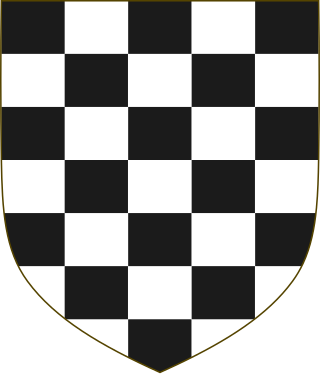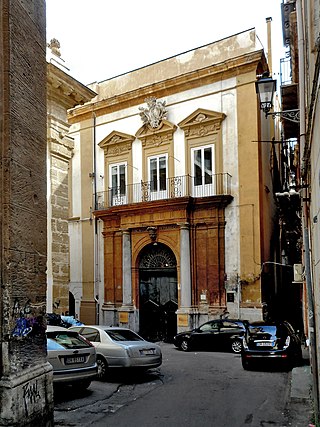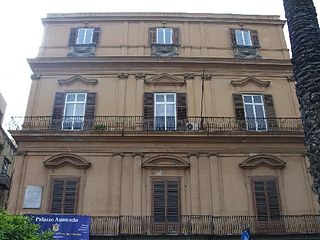
Palermo is a city in southern Italy, the capital of both the autonomous region of Sicily and the Metropolitan City of Palermo, the city's surrounding metropolitan province. The city is noted for its history, culture, architecture and gastronomy, playing an important role throughout much of its existence; it is over 2,700 years old. Palermo is in the northwest of the island of Sicily, by the Gulf of Palermo in the Tyrrhenian Sea.

Caltagirone is an inland city and comune in the Metropolitan City of Catania, on the island of Sicily, Southern Italy, about 70 kilometres (43 mi) southwest of Catania. It is the fifth most populous municipality of the Metropolitan City, behind Catania, Acireale, Misterbianco and Paternò. Alongside Catania, it is the only town that is a seat of a tribunal in the former province. Since 1987, the comune has obtained the City title, through a presidential act. After Caltanissetta, it is the second-most populous comune in Central Sicily.

Sicilian Baroque is the distinctive form of Baroque architecture which evolved on the island of Sicily, off the southern coast of Italy, in the 17th and 18th centuries, when it was part of the Spanish Empire. The style is recognisable not only by its typical Baroque curves and flourishes, but also by distinctive grinning masks and putti and a particular flamboyance that has given Sicily a unique architectural identity.

The Church of St. Mary of the Admiral, also called Martorana, is the seat of the Parish of San Nicolò dei Greci, overlooking the Piazza Bellini, next to the Norman church of San Cataldo, and facing the Baroque church of Santa Caterina in Palermo, Sicily, southern Italy.

Comitini is a comune (municipality) in the Province of Agrigento in the Italian region Sicily, located about 80 kilometres (50 mi) southeast of Palermo and about 13 kilometres (8 mi) northeast of Agrigento. The town is located on a hilly area, 346 metres (1,135 ft) above sea level.

Gravina di Catania is a comune (municipality) in the Metropolitan City of Catania in the Italian region Sicily, located about 160 kilometres (99 mi) southeast of Palermo and about 6 kilometres (4 mi) north of Catania.

The Palazzo Beneventano del Bosco is a large urban palace, located on piazza Duomo, across from the present city hall and diagonal to the Cathedral of Syracuse, in the island of Ortigia in the city of Syracuse in Sicily, Italy.
Quattro Canti, officially known as Piazza Vigliena, is a Baroque square in Palermo, region of Sicily, Italy; it is considered the center of the historic quarters of the city. The site is the intersection of two major streets in Palermo, the Via Maqueda and the Corso Vittorio Emanuele, and at this intersection are the corners of all four of the ancient quarters of Palermo: the Kalsa (SE); Seralcadi (SW); Albergaria (wW); and Castellammare (NE). On the southwest corner stands the church of San Giuseppe dei Padre Teatini. A few steps away along the flank of this church, behind the Southeast corner building, along Via Maqueda is the Piazza and Fontana Pretoria, sandwiched between this church and Santa Caterina. A few more steps reaches San Cataldo and the ancient Norman church of La Martorana. About 500 meters west along the Cassaro is the piazza of the Cathedral of Palermo and the adjacent Palazzo Normani.

The Pepoli family was an Italian aristocratic banking family of Bologna, in northern Italy. They were lords of the city for thirteen years in the fourteenth century. A branch of the family moved to Trapani in Sicily and were granted several feudal lordships and baronies.

Palazzo Natoli is a Baroque palace in Palermo, in the Mediterranean island of Sicily. It was built by Vincenzo Natoli in 1765. It has a fine entrance on via S. Salvatore, and frescoes by Gioacchino Martorana.

Gioacchino Martorana was a Sicilian painter. He was the son of Pietro Martorana and a member of an extended family of decorators and artists from Palermo.
Pietro Martorana (1705–1759) was a Sicilian painter. He was the father of Gioacchino Martorana and a member of an extended family of decorators and artists from Palermo.

The Praetorian Palace, also known as Palace of the Eagles, is a palace of Palermo. The building has an important role in the political life of the city, since it houses the mayor and the offices of the municipality of Palermo. It is located in the heart of the historic centre, between Via Maqueda, Piazza Pretoria and Piazza Bellini, in the same area of other well-known architectural landmarks like the Fontana Pretoria, the Baroque church of Santa Caterina and the Medieval churches of Martorana and San Cataldo.

Piazza Bellini is a square of Palermo. It is located in the heart of the city, near the central Via Maqueda and Piazza Pretoria, in the quarter of the Kalsa, within the historic centre of Palermo.

The following outline is provided as an overview of and topical guide to Palermo:

The House of Gravina, then Gravina Cruyllas, was a noble family of Norman origins, with roots stretching back to Rollo, the first ruler of Normandy.
The Palazzo Filangeri-Cutò is a Baroque-style aristocratic palace located on via Maqueda 26 in the ancient quarter of Albergheria of central Palermo, region of Sicily, Italy. Once the urban palace of a wealthy and prominent family, since the 19th-century the palace has been subdivided into numerous apartments and businesses, and in dire need of restoration.

The Palazzo Celestri di Santacroce, also known as the Palazzo Sant'Elia is a Baroque-style aristocratic palace located on via Maqueda 90 in the ancient quarter of Kalsa of central Palermo, region of Sicily, Italy. Once the urban palace of a wealthy and prominent family, a large portion of the palace is now used for exhibitions and private functions. The palace is diagonal to the Southeast of the Palazzo Comitini, and just a block north of the church of the Assunta.

The Palazzo Asmundo is a late-Baroque aristocratic residence located on via Vittorio Emanuele, corner Via Pietro Novelli #3, in central Palermo, region of Sicily, Italy. The palace front faces the piazza and garden on the south flank of the Cathedral of Palermo. The privately owned palace is presently a museum and exhibition space.

The Palazzo Butera is a Baroque-style aristocratic palace located facing the Mediterranean in the ancient quarter of Kalsa of central Palermo, region of Sicily, Italy. On the shoreside, the long facade has a wide terrace, built atop the base of the former walls and called Passeggiata delle Cattive, in front of this is the park Foro Italico, in front, rising just south of Porta Felice and Via Vittorio Emanuele ; the access to the palace is from the land-side street of Via Butera.



















